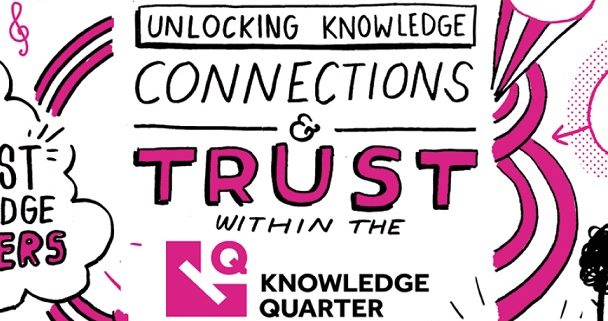KQ New Report: Unlocking Knowledge – Connections and Trust Within the Knowledge Quarter
The Knowledge Quarter (KQ) is pleased to announce the release of its first research report titled Unlocking Knowledge – Connections and Trust Within the Knowledge Quarter.
This research project is a first step in exploring the value of multi-sector clusters like the KQ. Quantitative and qualitative research to understand the connections and trust formed from the KQ network was undertaken between May and October 2016.
Authors: Alina Velias and Bernadette Elliott-Bowman
Date: December 2017
Click here to download and read the full report.
Executive Summary
Section One: Literature Review
In the first section, we summarise the literature on economic clusters and innovation districts. We suggest where the KQ fits within the modern definitions of these two phenomena, and show that it exhibits all the ingredients typical of what is defined as an innovation district. It combines the economic and productivity benefits of pure agglomeration clusters with the tacit knowledge spillover benefits of social network clusters.
We also explore the role of policy in supporting existing examples of clusters. There has been a gradual shift in policy from supporting industry specific clusters to fostering innovation ecosystems capable of working across disparate sectors and institutions. The enabling policy interventions range from improving social and physical infrastructure within clusters to creating collaborative leadership networks.
Section Two: Desk Research and Interviews
Through interviews with senior stakeholders from 21 partner organisations, we identified a number of opportunities and challenges facing the network. These were:
- A desire from smaller institutions to form partnerships with the wider network and particularly anchor institutions.
- A challenge for some organisations to engage locally, when funding incentives emphasise an ability to demonstrate national and international impact.
- A perception of cultural and long-term value forming from the formation of the KQ, but a challenge in quantifying the nature of its short-term benefit.
- A desire to deepen engagement within the KQ network, but concerns over the capacity available to engage with it fully.
Section Three: Survey of Knowledge Quarter Staff
Finally, 235 individuals employed at organisations within the KQ were surveyed on a range of issues; including trust, the nature and scale of existing networks and factors which might influence potential successful collaborations. Some of the key findings include:
- KQ employees generally form diverse contact networks. Seventy-two percent of respondents had some form of personal contact within another KQ institution, and of those connections, 53% were with organisations operating outside the respondent’s sector. However, only 32% of respondents felt that they knew at least one contact within a partner organisation that they could turn to for help and advice.
- More than 85% of respondents were interested in gaining personal contacts at more inter-sector than intra-sector KQ partners. Half of the respondents who were more interested in gaining intra-sector than inter-sector contacts were from the science and research sector. Survey respondents were also asked to identify which of a selection of generalised subsectors they were interested in learning more about, or making new connections within. No clear popularity trend was observed in the types of subsectors identified by respondents, reflecting the diverse and interdisciplinary nature of KQ.
- Employees in higher supervisory positions were more likely to have wider networks than those in non-supervisory positions, who struggled to make contacts outside their own organisation. This effect was found to be a result of a lack of time, both due to an individual’s workload and the perceived imposition of time limits by the individual’s supervisor.
- The most connected organisations in the KQ were large institutions that were generally well-established in the district. The majority of the organisations were non-profit anchor institutions, and half of them maintained previous institutional relationships with each other. In comparison, the least connected organisations were small and medium businesses which were often (but not always) physically isolated from other KQ partners.
- An individual’s perception or prior knowledge of an organisation’s brand can impact on their willingness to share knowledge with a new contact from that organisation. This has clear implications for smaller KQ partner organisations, which tend to have a smaller audience and are comparatively less well-known within the district.
- The fact that the likelihood of a positive response to communication increases when the sender and recipient have some form of prior connection, either through their organisations or a colleague, suggests that networking events may have a positive impact on the ability of partner organisation employees to connect with the wider KQ community. The KQ structure has the potential to enable smaller organisations to build valuable networks with larger anchor institutions.
Recommendations
Partner Institutions: Knowledge Quarter partner organisations should give junior staff the time and space to build their network within it. Informal network-building and participation in KQ activities should be viewed as a professional added-value activity. Smaller organisations should ensure there is a designated contact point to engage with KQ activities and the wider network.
Anchor Institutions: Anchor institutions should consider what support they can provide for smaller organisations in the network. This does not have to be financial support, but could include venue space, access to expertise or opportunities for training. Anchor institutions should also consider creating a budget to support more spontaneous collaborations with local KQ partners.
The Knowledge Quarter: The Knowledge Quarter should continue to do it what it can to reduce the ‘cost’ of collaboration through helping links form between organisations. In particular, it should continue to investigate how it can support small and medium sized organisations to engage with local community groups.
National Government: National Government should expand on this research. It should seek to understand the productivity gains which can be made by facilitating networks and collaborations within the growing number of UK innovation districts. It should also consider how the incentives provided by its funding conditions affect local networks. In particular, it should strive for a balance between incentivising national and international impact and meaningful local engagement.


